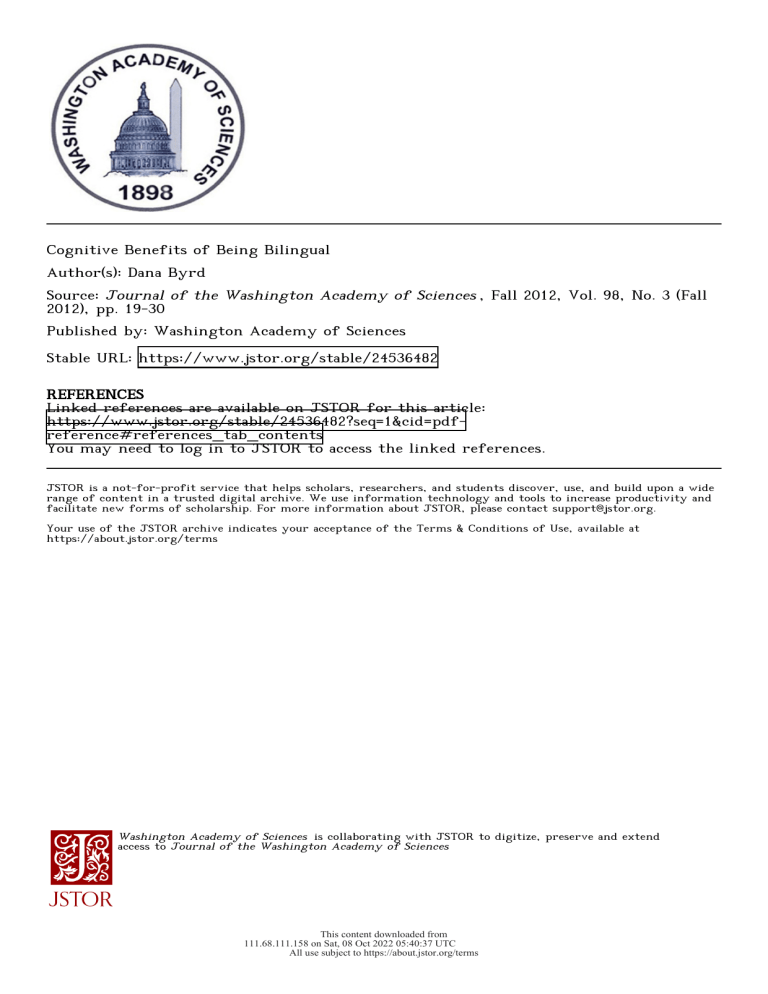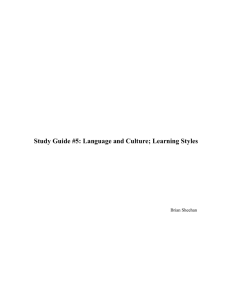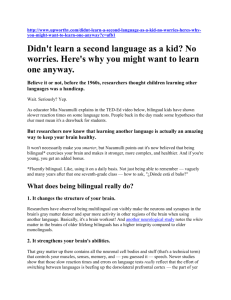
Cognitive Benefits of Being Bilingual Author(s): Dana Byrd Source: Journal of the Washington Academy of Sciences , Fall 2012, Vol. 98, No. 3 (Fall 2012), pp. 19-30 Published by: Washington Academy of Sciences Stable URL: https://www.jstor.org/stable/24536482 REFERENCES Linked references are available on JSTOR for this article: https://www.jstor.org/stable/24536482?seq=1&cid=pdfreference#references_tab_contents You may need to log in to JSTOR to access the linked references. JSTOR is a not-for-profit service that helps scholars, researchers, and students discover, use, and build upon a wide range of content in a trusted digital archive. We use information technology and tools to increase productivity and facilitate new forms of scholarship. For more information about JSTOR, please contact support@jstor.org. Your use of the JSTOR archive indicates your acceptance of the Terms & Conditions of Use, available at https://about.jstor.org/terms Washington Academy of Sciences is collaborating with JSTOR to digitize, preserve and extend access to Journal of the Washington Academy of Sciences This content downloaded from 111.68.111.158 on Sat, 08 Oct 2022 05:40:37 UTC All use subject to https://about.jstor.org/terms 19 Cognitive Benefits of Being Bilingual Dana Byrd Texas A & M University at Kingsviile Abstract Most language research has focused on monolingual speakers. However, bilingualism/multilingualism is far from unusual. Recent studies reveal that 50% of the world is multilingual and about 20% of households in the U.S. speak more than one language, with the majority using Spanish. Previously, researchers perceived bilingualism as a burden rather than a benefit, especially in children. The burden involves having to learn multiple vocabularies, grammars, and nuances, creating a potential for a smaller vocabulary and weaker associations between actual words' and their meaning, as reflected in slower response in naming objects. However, under the right circumstances, many bilinguals are fully functional in both languages, so deficits are not necessarily permanent or profound. In fact, evidence indicates that bilinguals not only have differences in non-language thinking and brain functioning from monolinguals, but also benefits over monolinguals. Research suggests that being bilingual has an effect if both languages are presented from an early age, changing the way bilinguals process and react to information. Being bilingual in childhood seems to accelerate complex cognitive processing. While this advantage appears less marked during the peak of cognitive ability (young adulthood), underlying changes in cognitive abilities and neurological structure carry forward into older adulthood, slowing cognitive decline. Interesting questions remain about the nature of the bilingualism and how it plays a role in generating benefits. Introduction The development and use of language is arguably the most important characteristic that separates humans from other species. To date, however, most language research has focused on monolingual subjects, in spite of the fact that bilingualism/multilingualism in today's world is far from unusual. Recent studies have revealed that 50% of the world is multilingual (Grosjean, 2010), and that approximately 20% of house in the United States speak more than one language, with the major U.S. bilingual speakers using Spanish (Shin & Kominshi, 2010). But how do bilinguals manage the different languages that t use? How is it that they select one language to use in one setting and t switch to another in another language in another context? How do switch from one language to the other casually as they converse w fellow bilingual? These questions all boil down to the question of h Fall 2012 This content downloaded from 111.68.111.158 on Sat, 08 Oct 2022 05:40:37 UTC All use subject to https://about.jstor.org/terms 20 bilinguals store, activate, and produce their languages. By extension, how has becoming bilingual/multilingual affected the development of their overall development of the mind? In recent years, knowledge about how our minds work has expanded greatly as the result of improved research techniques. Advances in verbal and nonverbal assessments provide much more specific information about cognitive development in areas of interest. Similarly neuroscientific research of the mind has been greatly enhanced through electroencephalographic (EEG) and functional magnetic resonance imaging (fMRI) studies. Together these research approaches have yielded important information about the cognitive and linguistic development of bilingual speakers. "Activation" of Listening and Production in More Than One Language It may not seem surprising that bilinguals, when spoken to, are listening for words in both languages, making themselves "open" to receiving information in either language. What is surprising, however, is that there is evidence that both languages are activated for language production at the same time, even for production of just a single word (Martin, Dering, Thomas, & Thierry, 2009). The convention for labeling a speaker's first, often stronger language is "LI," whereas the speaker's second language is labeled "L2." Hatzidaki, Branigan and Pickering (2011) reported that the degree of activation is stronger in the more dominant language (typically LI). Bilinguals may also be activating both grammar systems when generating language in an interchange, or at least when they are switching back and forth between the two languages (Hatzidaki, Branigan, & Pickering, 2011), as some bilinguals do automatically when interacting with their bilingual peers (Gollan & Ferreira, 2009). How do bilinguals handle this dual activation of languages? With this dual activation there may be largely unconscious, though in some cases conscious cognitive control that allows selection. This control may be activation of one language or inhibition of the other, or even the controlled alternating activation and inhibition upon switching back and forth between languages when speaking with someone who is equally bilingual (Kroll, Bobb, Misra, & Guo, 2008). This ability to switch between languages with such ease has been demonstrated through functional Magnetic Resonance Imaging, or fMRI, a measure of the blood flow in the brain during certain tasks. These images show that in Washington Academy of Sciences This content downloaded from 111.68.111.158 on Sat, 08 Oct 2022 05:40:37 UTC All use subject to https://about.jstor.org/terms 21 bilinguals the areas of the brain used for each of the two languages are the same (Wang, Xue, Chen, Xue, & Dong, 2007). The Burdens of Being Bilingual In past decades, and perhaps even today, researchers have perceived bilingualism as a burden rather than a benefit, especially in children. The burden involves having to learn multiple vocabularies, grammars, and even cultural nuances. As a result, there is the potential for a smaller vocabulary (Bialystok & Luk, 2011, Bialystok, Luk, Peets, & Yang, 2010) and "weaker links" or associations between actual words and meaning they represent, resulting in slower object naming (Bialystok, Craik, Green, & Gollan, 2009). Depending on their circumstances, many bilinguals are fully functional in both languages. Clearly, these deficits are not permanent or profound. Bilingualism, if so common that half the world population is bilingual, is not an abnormal state of brain development. In fact, there is a long-standing body of evidence that bilinguals have differences in their non-language thinking and brain functioning that show not only variation from monolinguals, but also benefits over monolinguals. The Benefits of Being Bilingual The benefits of bilingualism can appear as early as infancy, resulting in an improved early ability to form categories and interpersonal associations. Infants exposed to bilingual environments begin to use acoustic information to distinguish their two languages, a step toward understanding that there are cognitive categories that must be distinguished. Once past the pre-lingual state of development, young children being raised in bilingual environments learn to use the language appropriate to the person to whom they are speaking. Such accommodation to individual speakers may be the result of simple trial and-error learning. In other words, young bilingual children learn that if they correctly match the language with their conversational partner, they get positive results, but if they mismatch the language to the person, they get no results. Therefore, for early bilingual language learners, this learning is the beginning of understanding interpersonal association and context not yet acquired by their monolingual peers (Werker & Byers Heinlein, 2008). Putting it differently, early bilingual language learners may have an advantage over monolinguals in understanding others' states of mind. These preschoolers show evidence that they know that certain people will understand certain languages. This cognitive ability to Fall 2012 This content downloaded from 111.68.111.158 on Sat, 08 Oct 2022 05:40:37 UTC All use subject to https://about.jstor.org/terms 22 understand that there are differences in others' understanding is referred to as "Theory of Mind." Theory of Mind Emergence of Theory of Mind (ToM) is a major milestone for a preschooler: realizing that other persons can think, and that these other people think differently than the child does. For example, a young child without ToM might stand directly in front of the TV thinking, "I can see the TV, so everyone else in the house can see the TV too." A child achieves a more sophisticated state of Theory of Mind upon realizing that someone else can not only think differently than the child about the world, but that the other person may hold a false belief. This point can be illustrated using a standard ToM assessment. A preschool child is shown a box labeled for crayons and asked what he thinks is inside. The child predictably answers, "crayons." Next the child is shown that the box contains ribbons. A new person whom the child has never met comes into the room and the experimenter asks the child to name what the new person think is in the box. If the child answers "crayons," he has achieved ToM. The preschooler recognizes that the new person has a state of mind different than his own, and that the new person will reach the same conclusion about the crayon box that the child did in the past: that it contains crayons. If the child has not achieved ToM, he will think that the new person must share the same "state of mind" or knowledge as the child. In this situation, the child will reply that the box contains ribbons. How do Monolingual and Bilingual Preschoolers Compare in the Acquisition of ToM? Young monolingual preschoolers, about 3 years of age, usually fail ToM tests such as the one described above, whereas older preschoolers, about 5 years of age, pass this test. When younger preschoolers, just on the cusp of understanding ToM, are given the test an interesting difference is seen between monolingual and bilingual children. When presented this false belief task, a greater number of younger bilingual preschoolers than monolinguals passed the test demonstrating ToM, even when age and verbal ability were taken into account (Farhadian, Abdullah, Mansor, Redzuan, Gazanizadand, & Kumar, 2010). This false belief task was even tested to see whether a language advantage would further improve their ToM performance. Bilingual children were presented a version of the task in which the new person entering the room spoke a different language than Washington Academy of Sciences This content downloaded from 111.68.111.158 on Sat, 08 Oct 2022 05:40:37 UTC All use subject to https://about.jstor.org/terms 23 the person who knew the truth about the box of crayons. The same advantage was found in the bilingual children regardless of the language in which the stimuli were presented. So, younger bilingual preschool children can understand about other's thinking earlier and in a more sophisticated way than monolingual children. It was an advantage independent of language (Kovâcs, 2009). The study above, which controls for verbal ability, suggests that the child's more sophisticated ToM skills are not solely the result of more sophisticated verbal skills. But are these bilingual children also able to perform in a more advanced way than monolinguals on nonverbal tasks? Are their increased abilities more global, that is, beyond using language to enable their reasoning? One way to answer these questions, other than giving language-based tests and controlling for language, is to use non verbal tests. Do bilingual preschoolers still excel beyond monolingual preschoolers on those tasks? It appears that on certain tasks, but not all, the answer is yes. Preschool bilinguals have increased thinking abilities compared to monolinguals. How else can these tasks be described? Complex tasks, like the Theory of Mind tasks, require certain specific higher level thinking abilities that have been termed "executive functions" or "frontal lobe" functions. Executive Function and Frontal Lobe Development What are "executive functions?" According to the theory of cognitive development described by Baddeley (1996), executive functions are a type of higher-level cognitive function that requires careful control of attention. More specifically, in Baddeley's theory there is a part of human thinking called the "central executive." Its job is like that of an executive in a company: not to do the actual work, but to direct the cognitive work that is done. The central executive controls which cognitive functions receive attention in a given circumstance, and which cognitive functions are inhibited. A task that requires a great deal of attentional control or inhibition is referred to as "tapping into an executive function" (Baddeley, 1996). Another term frequently used in conjunction with the ability to focus and control our attention is "frontal lobe" development. What are frontal lobe functions? Why is this term used somewhat interchangeably with executive functions? The ability to focus and control our attention is neurologically seated in the frontal and prefrontal cortex, the front most Fall 2012 This content downloaded from 111.68.111.158 on Sat, 08 Oct 2022 05:40:37 UTC All use subject to https://about.jstor.org/terms 24 part of the human brain behind the forehead. Development of this area is late to develop in children, as anyone who has been around a young child can attest when they admonish the child to "pay attention" and "stop doing that." One reason children are late to develop attentional control and inhibitory ability is because this frontal area is the final portion of the brain to develop through the increasing myelination of the neurons in this area. Myelination is a process by which the neurons are wrapped with non-neuronal brain cells called glial cells. These glial cells allow the neuron responses in synchrony. They appear white, and therefore these myelinated areas are referred to as white matter, in contrast to the grey matter of non-myelinated areas (Fuster, 2002a-d, 2008). Behavioral Tests of Executive/Frontal Lobe Functioning in Children Evidence from a number of non-language tasks suggests tha preschool age bilingual children have better control over their attentio and their inhibition, or executive or frontal lobe functions, than do the monolingual peers. One test used to assess executive function is th Dimensional Change Card Sort or DCCS (Frye, Zelazo, & Palfai, 1995 (Zelazo, Frye, & Rapus, 1996). This task, in its most basic form, contain cards that differ in two dimensions, such as color and shape. For example, some cards are red and some blue. The same cards also come in two other denominations, such as boat cards and car cards. The children are asked to sort the cards based on color. Then the game is switched and the children are asked to sort on the basis of the other category, shape. Young monolingual preschoolers, approximately 3 years of age, committed the error of continuing to sort the cards based on the first category (color), while older monolingual preschoolers, approximately 5 years of age, successfully sorted based on the new category (Zelazo, 2006). The bilingual subjects outperformed the monolingual subjects at a younger age when asked to inhibit paying attention to the perceptual differences in the cards that continue to distract the monolingual children, in this case colors. What if a twist is put on the game? A twist was designed by Bialystok and Martin (2004) further to determine which type(s) of cognitive development are stronger in bilingual preschool subjects when compared to their monolingual peers. The first category involves some surface/perceptual attribute like color (red vs. blue). The second category involves something deeper in meaning, something more semantic/representational, such as function (toys vs. something to wear). In this case the children were asked to sort based on the surface/perceptual Washington Academy of Sciences This content downloaded from 111.68.111.158 on Sat, 08 Oct 2022 05:40:37 UTC All use subject to https://about.jstor.org/terms 25 category first, then they were switched to sorting along representational/semantic dimensions (toys vs. something to wear). When this twist had been added, the bilingual benefit disappeared. Bilingual and monolingual subjects alike committed the error of continuing to sort based on the first category instead of attending to the second category. This result suggests that the perceptual-to-perceptual shift is easier for bilinguals, but the perceptual-to-representational/semantic shift proved just as challenging to bilingual and monolingual preschoolers alike. Therefore, there are limits on the benefits of attentional control of the central executive or frontal lobes in bilinguals. Bialystok and Martin's study showed that young bilingual preschoolers demonstrated benefits only when there is selective inhibition of attention related to surface rather than deep meaning. A study by Carlson and Meltzoff (2008) expanded research by Bialystok and others in multiple studies, producing a 9-test batteiy of executive function tasks, in which the performance of native bilingual children, those who are taught English through an "immersion program", was compared to their monolingual peers. Six subtests were categorized as those involving "conflicting information" regarding their cues for action. For example, the subjects were asked to sort on the basis of color, but if the card also had a gold star, the subjects were expected to sort on the basis of shape. Another subtest involved having the subjects play "Simon says." The other three subtests focused on the kindergarteners delaying their response according to the examiner's instructions. When independent tests were statistically grouped, the benefits of bilingualism were seen only on the tests where the children were presented conflicting information in their cues for action. In contrast, those subtests that assessed delaying responses did not show group differences (Carlson & Meltzoff, 2008). These findings can be seen as more evidence toward the hypothesis that bilinguals deal better with surface conflicting information tasks than monolinguals do. The results of the study revealed that, even though the native bilingual children as a group had a lower socioeconomic status, the native bilingual speakers outperformed their monolingual peers, a finding consistent with the studies by Bialystok and Martin (2004). Carlson and Meltzoff s study also revealed that students who have been enrolled in an English immersion program did not perform differently than the monolingual subjects. These findings suggest that the bilingual advantage must be developed over an extended period of time, beginning at a very early age. Fall 2012 This content downloaded from 111.68.111.158 on Sat, 08 Oct 2022 05:40:37 UTC All use subject to https://about.jstor.org/terms 26 Bilingual Differences Beyond Early Childhood Do the more advanced executive functions found in native bilingual preschoolers and kindergarteners persist throughout life Bilingual differences have been found in young children in executive functions, specifically those that require attentional control and inhibition based on conflicting information (Bialystok & Craik, 2010). These bilingual benefits are seen in young children, but interestingly, the benefit become more muted in adulthood, present only when the task is at its most challenging (Costa, Hernandez, & Sebastiân-Gallés, 2008). Bilingual differences then re-emerge in late adulthood. It is possible that these periods of development where there are changing amounts of myelinatio and individual differences in neural development may be periods where the bilingual effect is most evident (Bialystok, Craik, & Luk, 2012). Research has shown that frontal lobe functions are also among the earliest to decline, with the amount of white matter declining over late adult years, even as part of healthy aging (Bartzokis, Sultzer, Lu, Nuechterlein, Mintz, & Cummings, 2004). It is for this reason that thes pivotal times of transition in development and change in childhood an later adulthood are of such great interest in the research of higher leve cognitive functions such as attentional control. It is also why - if researchers suspect that higher level thinking, executive functions, or frontal lobe functions differ between bilinguals and monolinguals - they focus on these times of transition, childhood and old age, when attentional control and amounts of frontal white matter exhibit the greatest changes. Bilingual Benefits in Old Age Research of cognitive benefits in older bilingual individuals has been performed through both behavioral and neuroscientiflc studies. As was found in the previously cited studies with young bilingual children there is a bilingual benefit in the executive functions of older adults. When Bialystok, Craik, and Luk (2008) administered a battery of tests to older bilingual and monolingual adults, the results were mixed. Language task were performed less well by the bilinguals, the working memory task were performed equally well by monolinguals and bilinguals, and th executive function tasks were performed better by the bilinguals (Bialystok, Craik, & Luk, 2008). Results of a study by Bialystok, Craik, Klein, and Viswanathan (2004) revealed a bilingual advantage in older adults in a specific non language executive function task, the Simon task. In this task, subject Washington Academy of Sciences This content downloaded from 111.68.111.158 on Sat, 08 Oct 2022 05:40:37 UTC All use subject to https://about.jstor.org/terms 27 were presented a color block appearing in one of two colors, in this case red and blue. Both younger and older adult participants were asked to press the left key when presented a red block, but push the right key if presented a blue block. On some trials the color block was presented on the same side as the key. On other trials the color block was presented on the opposite side of the screen; for example on the left side of screen a blue block appears, cueing pressing of the far right key. On the second type of trials, each participant tries to inhibit the conflicting cue to press the button on the same side, resulting in slower reaction times and more mistakes for all subgroups of subjects. This task requires inhibition of response based on perceptual conflict. As expected, younger participants performed better than older adult participants. This result reflects the deterioration of white matter in the frontal lobes, causing executive functions to decline in old age. However, the older bilingual adults were found to perform better and faster on this task than the older monolingual adults, with a greater bilingual benefit for older compared to younger adults. So there is additional evidence, this time on the other end of the life span, that there is an advantage in higher level cognitive processing in bilingual adults. With the increased percentage of the population reaching later age, and with overall life expectancy expanding, understanding healthy aging has become a focus of research. What is it about being bilingual that results in this advantage of appearing to slow cognitive decline in older adults? Neuroscience has been able to provide insight, particularly research focusing on the frontal regions of the brain. More specifically, recent neuroscientific advances have allowed for direct exploration of differences in white matter myelination in the brains of bilinguals compared to monolinguals. It is known that neurons with a greater amount of white matter have water running through them (as compared to diffusing out), as occurs to a greater extent in unmyelinated gray matter. Diffusion tensor imaging (DTI) is structural magnetic resonance imaging that can detect these patterns of directional water paths in neurons and thus detect the amount of white matter in the brain. There is a decrease in white matter in old age seen throughout the brain, including the frontal areas of the brain. The important connections between this executive part of the brain and the more anterior portions of the brain are thought to be how this frontal executive area supplies attention and inhibition to other working areas of the brain. A recent study using DTI compared the brains of older bilingual and monolingual adults. More myelinated white matter was observed in the brains of the bilingual Fall 2012 This content downloaded from 111.68.111.158 on Sat, 08 Oct 2022 05:40:37 UTC All use subject to https://about.jstor.org/terms 28 participants, connecting both the hemispheres together as well as connecting frontal parts of the brain to more anterior parts (Luk, Bialystok, Craik, & Grady, 2011). This study of older adults and the bilingual brain stands out as measuring a population where the white matter of the frontal lobes is in flux, and where the bilingualism benefits appear very marked. What Is The Benefit? Conclusions and Future Studies What is it that bilinguals can do better than monolinguals? Th research presented in this paper suggests that being bilingual has an effe if both languages are presented from an early age. In childhood, bei bilingual seems to accelerate complex cognitive processing. While thi advantage appears less marked during the peak of cognitive ability (yo adulthood), underlying changes in cognitive abilities and neurolog structure carry forward into older adulthood, slowing the cognit decline. There are still many questions to ask about the nature of the bilingualism and how it plays a role in generating the bilingual benefit. How early must an individual become bilingual in order to gain the "bilingual advantage"? Also, what are the multiple ways to be bilingual and the degrees of bilingualism? For example, there is the passive bilingual, completely proficient in a first language, who may be able to understand what is spoken in the second language but unable to produce speech in the second language. Will these individuals still show the bilingual benefit? There is also the question of the environment in which the two languages are spoken. If an individual speaks only his first language at home, but uses a second language exclusively at school or work, is that the same as someone who is code switching all day (switching back and forth between languages, sometimes within the same sentence)? What happens to the individual who learned his native language as a young child, then immigrated to a country using an entirely different language? Will the suppression of the first language affect the neurological bilingual advantage in later years? With so many questions still unanswered and new techniques of neuroscience and assessment to help answer them, much will be learned about the fascinating phenomenon of the bilingual benefit. Washington Academy of Sciences This content downloaded from 111.68.111.158 on Sat, 08 Oct 2022 05:40:37 UTC All use subject to https://about.jstor.org/terms 29 References Baddeley, A. D. (1996). Exploring the central executive. Quarterly Journal of Experimental Psychology. 49A, 5-28. Bartzokis, G., Sultzer, D., Lu, Po H., Nuechterlein, Κ. H., Mintz, J., & Cummings, J. L. (2004). Heterogeneous age-related breakdown of white matter structural integrity: Implications for cortical "disconnection" in aging and Alzheimer's disease. Neurobiology of Aging, 25, 843-51. Bialystok, E., & Craik, F. I. M. (2010). Structure and process in lifespan cognitive development. In: The Handbook of Life-Span Development: Biology, Cognition and Methods Across the Life-Span. R. M. Lerner & W. F. Overton (Eds), Hoboken, Ν J: Wiley, pp. 195-225. Bialystok, E., Craik, F. I. M., Green, D. W., & Gollan, T. H. (2009). Bilingual minds. Psychological Science in the Public Interest. 10, 89-129. Bialystok, E., Craik, F. I. M., Klein, R., & Viswanathan, M. (2004). Bilingualism, aging, and cognitive control: Evidence from the Simon Task. Psychology and Aging. 19,290-303. Bialystok, E., Craik, F. I. M., & Luk, G. (2008). Lexical access in bilinguals: Effects of vocabulary size and executive control. Journal ofNeurolinguistics, 21, 522 538. Bialystok, E., Craik, F. I. M., & Luk, G. (2012). Bilingualism: Consequences for mind and brain. Trends in Cognitive Sciences, 16,240-250. Bialystok, E., & Luk, G. (2011). Receptive vocabulary differences in monolingual and bilingual adults. Bilingualism: Language and Cognition, 15, 397-401. Bialystok, E., Luk, G., Peets, K. F., & Yang, S. (2010). Receptive vocabulary differences in monolingual and bilingual children. Bilingualism: Language and Cognition, 13, 525-531. Bialystok, E., & Martin, M. M. (2004). Attention and inhibition in bilingual children: Evidence from the dimensional change card sort task. Developmental Science, 7, 325-339. Carlson, S. M., & Meltzoff, A. N. (2008). Bilingual experience and executive functioning in young children. Developmental Science. 11,282-298. Costa, Α., Hernandez, M., & Sebastiân-Gallés, Ν. (2008). Bilingualism aids conflict resolution: Evidence from the ANT task. Cognition. 106, 59-86. Farhadian, M., Abdullah, R., Mansor, M., Redzuan, M., Gazanizadand, N., & Kumar, V. (2010). Theory of mind in bilingual and monolingual preschool children. Journal of Psychology. 1, 39-46. Frye, D., Zelazo, P. D., & Palfai, T. (1995). Theory of mind and rule-based reasoning. Cognitive Development. 10, 483-527. Fuster, J. M. (2002a). Prefrontal cortex in temporal organization of action. In: The Handbook of Brain Theory and Neural Networks. Second Edition. M.A. Arbib (Ed.), Boston, Mass: The MIT Press, pp. 905-910. Fuster, J. M. (2002b). Cortical memory. In: The Handbook of Brain Theory and Neural Networks. Second Edition. M.A. Arbib (Ed.), Boston, Mass: The MIT Press, pp. 290-294. Fuster, J. M.(2002c). Frontal lobe and cognitive development. Journal of Neurocytology. 31, 373-385. Fuster, J. M. (2002d). Physiology of the executive functions: The perception-action cycle. In: Principles of Frontal Lobe Function. D.T. Stuss & R.T. Knight Fall 2012 This content downloaded from 111.68.111.158 on Sat, 08 Oct 2022 05:40:37 UTC All use subject to https://about.jstor.org/terms 30 (Eds.), Oxford, UK: Oxford University Press, pp. 96-108. Fuster, J. M. (2008). The Prefrontal Cortex (Fourth Edition) London, UK: Academic Press. Gollan, T. H., & Ferreira, V.S. (2009). Should I stay or should I switch? A cost-benefit analysis of voluntary language switching in young and aging bilinguals. Journal of Experimental Psychology: Learning, Memory, & Cognition. 35, 640-665. Grosjean, F. (2010). Bilingual: Life and Reality. Cambridge, Mass: Harvard University Press. Hatzidaki, Α., Branigan, H. P., & Pickering, M. J. (2011). Co-activation of syntax in bilingual language production. Cognitive Psychology. 62, 123-150. Kovâcs, A. M. (2009). Early bilingualism enhances mechanisms of false-belief reasoning. Developmental Science, 12, 48-54. Kroll, J. F., Bobb, S. C., Misra, M., & Guo, T. (2008). Language selection in bilingual speech: Evidence for inhibitory processes. Acta Psychologica. 128,416-430. Luk, G., Bialystok, E., Craik,F. I., & Grady, C. L. (2011). Lifelong bilingualism maintains white matter integrity in older adults. Journal of Neuroscience. 31, 16808-16813. Martin, C. D., Dering, B., Thomas, Ε. M., & Thierry, G. (2009). Brain potentials reveal semantic priming in both the 'active' and the 'non-attended' language of early bilinguals. Neuroimage, 47,326-333. Shin, H. B., & Kominski, R. A. (2010). Language Use in the United States: American Community Survey Reports, ACS-12. Washington, DC: U.S. Bureau of the Census; 2010. Wang ,Y, Xue, G., Chen C., Xue, F., & Dong Q. (2007). Neural bases of asymmetric language switching in second-language learners: An ER-fMRI study. Neuroimage, 35, 822-870. Werker, J. F., & Byers-Heinlein, K. (2008). Bilingualism in infancy: First steps in perception and comprehension, Trends in Cognitive Sciences, 12, 144-151. Zelazo, P. D. (2006). The dimensional change card sort (DCCS): A method of assessing executive function in children. Nature Protocols, 1, 297-301. Zelazo, P. D., Frye, D., & Rapus, T. (1996). An age-related dissociation between knowing rules and using them. Cognitive Development, 11, 37-63. Bio Dana Byrd's general interest is understanding cognition through the life span and neurological changes that underlie both age and special population differences in cognition. She has explored life-span development of higher level cognition utilizing behavior, electroencephalogram, and other psychophysiological measures. She holds bachelors (New College), masters, and PhD degrees (both at the University of Florida) in Psychology. She did Postdoc work at Columbia Medical University, and has been on the faculty at Texas A&M University-Kingsville since 2011. Washington Academy of Sciences This content downloaded from 111.68.111.158 on Sat, 08 Oct 2022 05:40:37 UTC All use subject to https://about.jstor.org/terms






